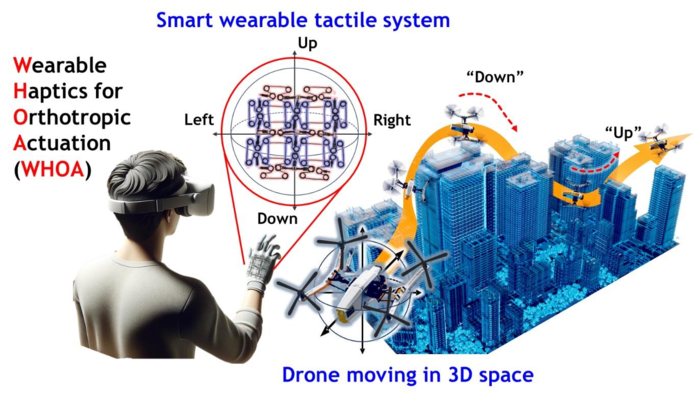
Overview of directional information haptic feedback that aids spatial awareness in 3D environments and assists in controlling drones in virtual and real settings.,
, ‘The Korea Advanced Institute of Science and Technology (KAIST, President Kwang-Hyung Lee) has developed wearable haptic technology that intuitively delivers remote-controlled drone-collected spatial data to operators through tactile feedback.’,
,
, “On the 21st, KAIST announced that a research team led by Professor Oilgwon of the Department of Mechanical Engineering has developed such ‘Orthogonal Direction Control Wearable Haptic (WHOA)’ technology.”,
,
, ‘Haptics is a technology that conveys information through touch beyond visual and auditory means, providing physical feedback that can be perceived through the skin.’,
,
, ‘The core material of the technology, shape memory alloy, is a special metal that returns to its original form when heated to a specific temperature and is used as an actuator to implement tactile feedback.’,
,
, “The research team developed a technology using a lightweight and simple ‘orthogonal metastructure’ that can reconstruct 3D spatial information into tactile feedback, pioneering a new domain in spatial awareness-based haptic navigation.”,
,
, “The developed technology enables effective mobility control in disasters, fires, and extreme environments in a way that allows you to ‘feel’ the surroundings without relying on visual information. Even when visual information is limited, direct detection of spatial information enables stable and efficient operation.”,
,
, ‘The tactile feedback is designed to convey unique haptic patterns upon detecting obstacles in front, in addition to spatial movement directions such as left, right, up, down, forward, and backward.’,
,
,

,
, ‘This technology generates independent tactile modes that are perpendicular to each other, allowing users to receive spatial information through touch when worn on places like the arms or feet.’,
,
, ‘When wearing WHOA, users receive three-dimensional spatial information feedback through a combination of independent tactile modes in horizontal and vertical directions. It is designed to operate in small spaces like inside shoes to minimize fatigue during long-term wear while allowing users to discern the next direction to move with hands-free.’,
,
, ‘The research team demonstrated a drone navigation system applying WHOA in a virtual reality (VR) environment. In a simulation mimicking a fire scene building, a user wearing WHOA controlled a drone to avoid danger zones and carry out rescue operations.’,
,
, ‘Professor Oilgwon said, “This technology represents a new form of navigation method that allows visually impaired individuals to receive guidance through touch.” He added, “The tactile delivery of three-dimensional spatial information can be utilized in remote drone and robot controls in disaster, fire environments, or unmanned and manned teaming (MUM-T) systems in defense.”‘,
,
, ‘This research, with Dr. O Se-woong and Master Manan Khan participating as co-first authors, was published in Advanced Materials on the 8th.’,
,
, ‘Meanwhile, this study was supported by the Mid-Career Researcher Program promoted by the Ministry of Science and ICT and the National Research Foundation of Korea.’,
,
,

